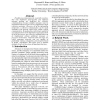Free Online Productivity Tools
i2Speak
i2Symbol
i2OCR
iTex2Img
iWeb2Print
iWeb2Shot
i2Type
iPdf2Split
iPdf2Merge
i2Bopomofo
i2Arabic
i2Style
i2Image
i2PDF
iLatex2Rtf
Sci2ools
85
Voted
IPPS
1998
IEEE
1998
IEEE
A Case for Aggregate Networks
Parallel processing networks, even full crossbars, that only implement point-to-point and multicast message passing are inefficient for collective communications because multiple messages must be transmitted to/from each processorto implement a single collective operation. However, all of the information needed for a collective communication can be made available to the network control logic within a single communication. By making this control logic capable of executing functions on the information aggregated from all of the processors, any collective communication can be implemented without additional messages or processor involvement. Networks with such logic are called aggregate networks and are capable of performing routing, computation, and storage/retrieval of global information. This paper gives a detailed example of each of these types of aggregate functions.
Collective Communication | Control Logic | Distributed And Parallel Computing | IPPS 1998 | Single Collective Operation |
Related Content
| Added | 05 Aug 2010 |
| Updated | 05 Aug 2010 |
| Type | Conference |
| Year | 1998 |
| Where | IPPS |
| Authors | Raymond Hoare, Henry G. Dietz |
Comments (0)

